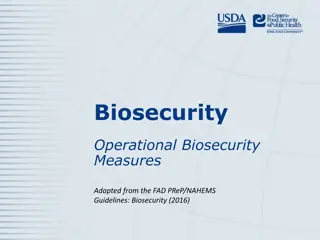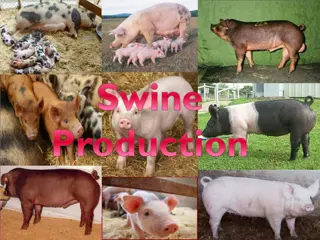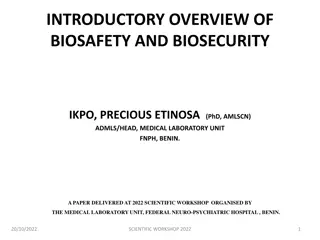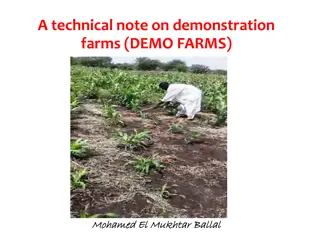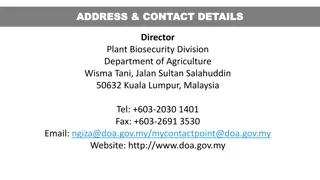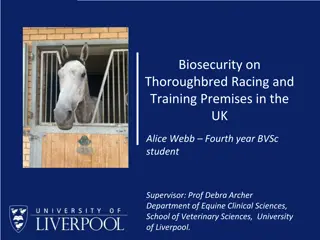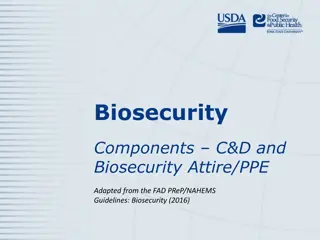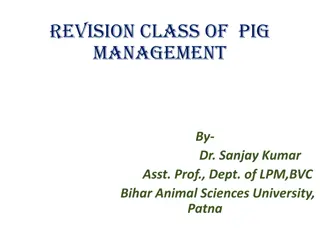Biosecurity Guidelines for Pig Farms: Importance and Practices
Biosecurity is crucial in pig farming to prevent the introduction and spread of diseases. Implementation of measures, such as proper farm location, herd size management, and careful introduction of new pigs, is essential. National biosecurity strategies and farm/state-level practices play a vital role in disease control. This article emphasizes the significance of biosecurity in pig farming and provides practical guidelines for maintaining a healthy pig population.
Download Presentation

Please find below an Image/Link to download the presentation.
The content on the website is provided AS IS for your information and personal use only. It may not be sold, licensed, or shared on other websites without obtaining consent from the author. Download presentation by click this link. If you encounter any issues during the download, it is possible that the publisher has removed the file from their server.
E N D
Presentation Transcript
BIO SECURITY GUIDELINES FOR PIG FARMS
DEFINATION OF BIOSECURITY Biosecurity is defined as implementation of measures that reduce the risk of the introduction and spread of disease agents; it requires the adoption of a set of attitudes and behaviours by people to reduce risk in all activities involving domestic, captive/exotic and wild animals and their products
BIO-SECURITY AT NATIONAL LEVEL At national level biosecurity mainly concerns on the development of strategies to prevent the spread of disease outbreaks, control or eradication of endemic diseases and trans boundary disease transmission. The Dept. AH, Dairying & Fisheries, GOI should identify major economic disease of pig and undertake action plan to control and eradication of the disease on priority basis. The Dept. Should also develop strategies to establish quarantine/ check post at the porous borders of the country to prevent illegal migration of pigs from the neighbouring countries.
BIO SECURITY AT FARM/ STATE LEVEL A. LOCATION OF FARM. Location of farm is very critical in control of disease. Situated in isolated area far away from other animal farms. In densely populated pig farm areas, it becomes very difficult to prevent the entry of some disease into the farm.
B. HERD SIZE Many pathogenic microorganisms need a host to multiply. Each infected pig can generate and excrete millions of virus particles into the environment. If a new disease enters into a large herd, there are many susceptible pigs to infect. In small herd, it may take very short time before the entire herd is infected. Therefore infection in small herd may not last long but in large herd outbreak will last longer because there is no shortage of susceptible pigs.
C. INTRODUCTION OF NEW PIGS. Bringing new pigs is the single most important method of introducing a new disease in the farm. For better disease control: 1. Pigs to be brought from one farm/ source, if possible. 2. If this is not possible, then the boars to be brought from one herd and the gilts from another. 3. Bringing stocks from many sources end up with a collection of nearly all the major disease/ pathogens of pigs.
D. REPLACEMENT OF STOCKS. Buying of stocks from different sources should be avoided to the extent possible. Closed herds (Farms that breed their own replacements) generally have the fewest problems. Stocks to be purchased from a farm with high health status with sound disease control program. The general principle is that the health status of the farm where the pigs are kept (source farm) must be superior to the receiving farm.
E. QUARANTINE Very useful method to detect disease and prevent the spread. Usually quarantine is for 3 weeks. During this period new pigs to be observed for signs of disease, and should be treated if found. ( preferably done on the farm of origin) It must be kept in mind that quarantine is not a perfect method for preventing disease. There are some chronic disease where recovered pig will not show any sign of disease but will remain as carriers.
F. PIG BUYERS Customer is also a potent source of bringing infections in the farm. Should not be allowed to enter inside the farm area. If at all required they should follow the bio security measures like change of shoes and putting apron etc. In order to prevent the disease in the farm.
G. VISITORS Determine whether it is necessary to allow visitors in side the farm. If at all necessary, a minimum gum-boots to be provided by farm to be wore. Footbaths, chlorine and alkaline compounnds are useful to destroy bacteria and virus.
H. FENCING All pig farms should be fenced off. A simple chain- link fence should keep out people and animals such as dogs. I. WORKERS. Should not bring any human food into the compound. There should be a dressing room in the office where the workers can change their clothing gum boots.
J. VACCINATION. K. FARM DESIGN. Farm design should be done scientifically Over crowding and poor ventilation should be avoided. Older pigs have high resistance compared to younger ones. Therefore different age groups should be kept separately.
L. MANAGEMENTAL PRACTICES. Scientific managemental practices should be adopted.
ROUTES OF DISEASE TRANSMISSION AND IMPLICATIONS FOR BIOSECURITY Direct pig-to-pig contsct Semen Airborne disease Visitors Vehicles and fomites Pig feed and drinking water Pig manure and bedding Birds, bats, rodents, wild pigs and stray/ domestic animals and arthropods.
TEN STEP GUIDE IN IMPLEMENTING AN EFFECTIVE BIO SECURITY PALN IN PIG FARM. 1. Replacement stock should be quarantined and it should be ensured that their health status is compatible with the existing herd. 2. Entry to farm should be restricted only to essential personnel and their entry should be recorded. 3. Boots and coveralls should be provided for staffs and visitors for each shed.
4. Staffs should be dedicated boots and coveralls upon entering eash different sheds. Clean footbaths may be appropriate at the entry point. 5. Vaccination programme should be followed regularly. 6. Entry of equipments and other materials to the farm should be minimized and appropriate precautionary measures such as disinfection, removal from shipping boxes etc. Should be strictly followed.
7. Entry of wild animals (rats, birds, insects)m or pets ( dogs, cats) on the farm should be prevented. 8. Semen should be used from a known source, which routinely tests against major infectious agents that can be transmitted through semen. 9. It should be ensured that feed and watersources are free from infectious agents. 10. Biosecurity plan and herd health program, including vaccination protocals should be reviewed on a regula basis.


